Ornithocheirus
| Ornithocheirus Temporal range: Late Cretaceous, 110Ma | |
|---|---|
 | |
| Holotype of O. simus, CAMSM B54428, and referred specimen CAMSM B54552 | |
| Scientific classification | |
| Kingdom: | Animalia |
| Phylum: | Chordata |
| Order: | †Pterosauria |
| Family: | †Ornithocheiridae |
| Subfamily: | †Ornithocheirinae Seeley, 1870 |
| Genus: | †Ornithocheirus Seeley, 1869 |
| Type species | |
| †Pterodactylus simus Owen, 1861 | |
| Species | |
| |
| Synonyms | |
| |
Ornithocheirus (from Greek "ορνις", meaning bird, and "χειρ", meaning hand) is a pterosaur genus known from fragmentary fossil remains uncovered from sediments in the UK.
Several species have been referred to the genus, most of which are now considered as dubious species, or members of different genera, and the genus is now often considered to include only the type species, Ornithocheirus simus. Species have been referred to Ornithocheirus from the mid-Cretaceous period of both Europe and South America, but O. simus is known only from the UK. Because O. simus was originally named based on poorly preserved fossil material, the genus Ornithocheirus has suffered enduring problems of zoological nomenclature.
Fossil remains of Ornithocheirus have been recovered mainly from the Cambridge Greensand of England, dating to the beginning of the Albian stage of the late Cretaceous period, about 110 million years ago.[1] Additional fossils from the Santana Formation of Brazil, dating to 112-108 million years ago, are sometimes classified as species of Ornithocheirus,[2] but have also been placed in their own genera, most notably Tropeognathus.
Description
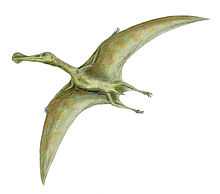
The original material of Ornithocheirus simus, recovered from England, indicates a mid-sized species with a wing span of 2.5 m (8.2 ft). Referred specimens attributed to Ornithocheirus simus can reach 5 m (16.5 ft).
O. simus bore a distinctive convex "keeled" crest on its snout.[3] Unlike the related Anhanguera and Coloborhynchus, which had an expanded rosette of teeth at the jaw tips, Ornithocheirus species (including O. simus) had straight jaws that narrowed toward the tip. Also unlike related pterosaurs, the teeth of Ornithocheirus were mostly vertical, rather than set at an outward-pointing angle. They also had fewer teeth than related species.[3]
The type specimen of Ornithocheirus simus is represented only by a broken piece of the upper jaw tip. While it does preserve several characteristic features of Ornithocheirus, it is nearly identical to comparable bones in Tropeognathus mesembrinus, making clear distinction between these two species impossible.[3]
Discovery and naming
During the 19th century, in England many fragmentary pterosaur fossils were found in the Cambridge Greensand, a layer from the early Cretaceous, that had originated as a sandy seabed. Decomposing pterosaur cadavers, floating on the sea surface, had gradually lost individual bones that sank to the bottom of the sea. Water currents then moved the bones around, eroding and polishing them, until they were at last covered by more sand and fossilised. Even the largest of these remains were damaged and difficult to interpret. They had been assigned to the genus Pterodactylus, as was common for any pterosaur species described in the early and middle 19th century.

Young researcher Harry Govier Seeley was commissioned to bring order to the pterosaur collection of the Sedgwick Museum in Cambridge. He soon concluded that it was best to create a new genus for the Cambridge Greensand material that he named Ornithocheirus, "bird hand", as he in this period still considered pterosaurs to be the direct ancestors of birds, and assumed the hand of the genus to represent a transitional stage in the evolution towards the bird hand. To distinguish the best pieces in the collection, and partly because they had already been described as species by other scientists, he in 1869 and 1870 each gave them a separate species name: O. simus, O. woodwardi, O. oxyrhinus, O. carteri, O. platyrhinus, O. sedgwickii, O. crassidens, O. capito, O. eurygnathus, O. reedi, O. cuvieri, O. scaphorhynchus, O. brachyrhinus, O. colorhinus, O. dentatus, O. denticulatus, O. enchorhynchus, O. xyphorhynchus, O. fittoni, O. nasutus, O. polyodon, O. compressirostris, O. tenuirostris, O. machaerorhynchus, O. platystomus, O. microdon, O. oweni and O. huxleyi, thus 28 in total. As yet Seeley did not designate a type species.
When Seeley published his conclusions in his 1870 book The Ornithosauria, this provoked a reaction by the leading British paleontologist of his day, Richard Owen. Owen was not an evolutionist and he therefore considered the name Ornithocheirus to be inappropriate; he also thought it was possible to distinguish two main types within the material, based on differences in snout form and tooth position — the best fossils consisted of jaw fragments. He in 1874 created two new genera: Coloborhynchus and Criorhynchus. Coloborhynchus, "maimed beak", comprised a new species, Coloborhynchus clavirostris, the type species, and two species reassigned from Ornithocheirus: C. sedgwickii and C. cuvieri. Criorhynchus, "ram beak", consisted entirely of former Ornithocheirus species: the type species Criorhynchus simus and furthermore C. eurygnathus, C. capito, C. platystomus, C. crassidens and C. reedi.
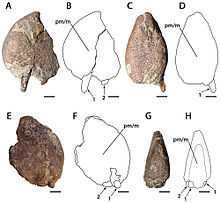
Seeley did not accept Owen's position. In 1881 he designated O. simus the type species of Ornithocheirus and named a new species O. bunzeli. In 1888 Edward Newton renamed several existing species names into: Ornithocheirus clavirostris, O. daviesii, O. sagittirostris, O. validus and O. giganteus; as new species he created: O. clifti, O. diomedeus, O. nobilis and O. curtus. Others had already named an O. umbrosus, O. harpyia, O. macrorhinus and O. hilsensis and would create an O. hlavaci, O. wiedenrothi and O. mesembrinus.
In 1914 Reginald Walter Hooley made a new attempt to structure the large number of species. Keeping the name Ornithocheirus, he added to it Owen's Criorhynchus, in which however Coloborhynchus was sunk, and to allow for a greater differentiation created two new genera, again based on jaw form: Lonchodectes and Amblydectes. Lonchodectes, "lance biter", comprised L. compressirostris, L. giganteus and L. daviesii. Amblydectes, "blunt biter", consisted of A. platystomus, A. crassidens and A. eurygnathus. However, Hooley's classification was rarely applied later in the century, when it became common to subsume all the poorly preserved and confusing material under the name Ornithocheirus. In 1978 Peter Wellnhofer, assuming no type species had been designated, made Ornithocheirus compressirostris the type.
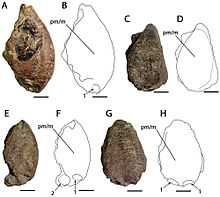
From the seventies onwards many new pterosaur fossils were found in Brazil, from formations about the same age as the Cambridge Greensand, 110 million years old. Contrary to the English material, these new finds included some of the best preserved large pterosaur skeletons and several new genera names were given to them, such as Anhanguera. This situation caused a renewed interest in the Ornithocheirus material and the validity of the several names based on it, for it might be possible that it could by more detailed studies be established that the Brazilian pterosaurs were actually junior synonyms of the European types. Several European researchers concluded that this was indeed the case. Unwin revived Coloborhynchus and Michael Fastnacht Criorhynchus, each author ascribing Brazilian species to these genera. However, in 2000 Unwin stated that Criorhynchus could not be valid. Referring to Seeley's designation of 1881 he considered Ornithocheirus simus, holotype CAMSM B.54428, to be the type species. This also made it possible to revive Lonchodectes, using as type the former O. compressirostris, which then became L. compressirostris. This position has not universally been accepted. Brazilian workers also typically reject the identification of their genera with European types. Unwin, and this caused no controversy, reaffirmed that most Ornithocheirus species are nomina dubia, names that are invalid because the fossils they refer to lack sufficient diagnostic features.
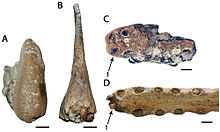
As a result, though over forty species have been named in the genus Ornithocheirus over the years, not a single one of them, not even O. simus, is currently recognized as valid by all pterosaur researchers. Often, there is a total lack of consensus; e.g. Tropeognathus mesembrinus named by Peter Wellnhofer in 1987 has afterwards been considered Ornithocheirus mesembrinus by David Unwin in 2003 (making Tropeognathus a junior synonym),[4] but as Anhanguera mesembrinus by Alexander Kellner in 1989, Coloborhynchus mesembrinus by André Veldmeijer in 1998 and Criorhynchus mesembrinus by Michael Fastnacht in 2001. Even earlier, in 2001, Unwin had referred the "Tropeognathus" material to O. simus in which he was followed by Veldmeijer; however the latter denied that O. simus is the type species in favor of O. compressirostris (alternately Lonchodectes), and used the names Criorhynchus simus and Cr. mesembrinus.[5] Kellner in 2000 again recognized Tropeognathus as a valid genus.
Formerly assignd species
In 2013, Rodrigues and Kellner found Ornithocheirus to be monotypic, containing only O. simus, and placed most other species in other genera, or declared them nomina dubia. They also considered O. platyrhinus a junior synonym of O. simus.[6]
Species previously assigned to Ornithocheirus:
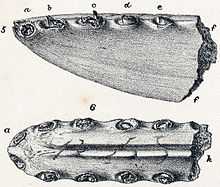
- O. compressirostris (Hooley, 1914) = Pterodactylus compressirostris Owen, 1851 [now classified as Lonchodectes]
- O. crassidens Seeley, 1870 [now classified as Amblydectes]
- O. cuvieri (Seeley, 1870) = Pterodactylus cuvieri Bowerbank, 1851 [now classified as Cimoliopterus]
- O. curtus (Hooley, 1914) = Pterodactylus curtus Owen, 1874
- O. giganteus (Owen, 1979) = Pterodactylus giganteus Bowerbank, 1846 [now classified as Lonchodraco]
- "O." hilsensis Koken, 1883 [possibly a theropod dinosaur]
- O. mesembrinus (Wellnhofer, 1987) = Tropeognathus mesembrinus Wellnfofer, 1987
- O. nobilis (Owen, 1869) = Pterodactylus nobilis Owen 1869
- O. simus (Owen, 1861) [originally Pterodactylus] (type)
- O. sedgwicki (Owen, 1859) = Pterodactylus sedgwickii Owen 1859 [now classified as Camposipterus]
- O. wiedenrothi Wild, 1990
Cimoliornis diomedeus, Cretornis hlavatschi, and Palaeornis clifti, originally misidentified as birds, have been assigned to Ornithocheirus in the past, but they are probably distinct genera instead, a position held by David Unwin. Cimoliornis may be closer to azhdarchoidea,[7] Cretornis is likely an azhdarchid,[8] and Palaeornis was shown to be a lonchodectid in 2009.[9] O. buenzeli (Bunzel 1871, often mis-spelled and mis-attributed as O. bunzeli, Seeley 1881), cited in the past as evidence of Late Cretaceous ornithocheirids,[10] has since been re-identified as a likely azhdarchid as well.[11]
In popular culture
A large pterosaur identified as Ornithocheirus was featured in an episode of the award-winning BBC television program Walking with Dinosaurs.[2] The episode depicted a large ornithocheirid of the Santana Formation of Brazil, Ornithocheirus mesembrinus, which is currently now classified in the distinct genus Tropeognathus.[12]
See also
References
- Haines, T., and Chambers, P. (2006). The Complete Guide to Prehistoric Life. Canada: Firefly Books Ltd.
Notes
- ↑ Vullo, R. and Neraudeau, D. (2009). "Pterosaur Remains from the Cenomanian (Late Cretaceous) Paralic Deposits of Charentes, Western France." Journal of Vertebrate Paleontology, 29(1):277-282. doi:10.1671/039.029.0123
- ↑ 2.0 2.1 Unwin, David M. (2006). The Pterosaurs: From Deep Time. New York: Pi Press. p. 246. ISBN 0-13-146308-X.
- ↑ 3.0 3.1 3.2 Fastnacht, M. (2001). "First record of Coloborhynchus (Pterosauria) from the Santana Formation (Lower Cretaceous) of the Chapada do Araripe of Brazil." Paläontologisches Zeitschrift, 75: 23–36.
- ↑ http://dml.cmnh.org/2003Sep/msg00388.html
- ↑ Veldmeijer, A.J. (2006). "Toothed pterosaurs from the Santana Formation (Cretaceous; Aptian-Albian) of northeastern Brazil. A reappraisal on the basis of newly described material." Tekst. - Proefschrift Universiteit Utrecht.
- ↑ Rodrigues, T.; Kellner, A. (2013). "Taxonomic review of the Ornithocheirus complex (Pterosauria) from the Cretaceous of England". ZooKeys 308: 1. doi:10.3897/zookeys.308.5559.
- ↑ Martill, D.M. 2010. The early history of pterosaur discovery in Great Britain. In: Moody, R., Bueefetaut, E., Naish, D. & Martill, D.M. (eds) Dinosaurs and other extinct saurians. Geological Society, London, Special Publication, 343, 20-45.
- ↑ Averianov, A.O. (2010). "The osteology of Azhdarcho lancicollis Nessov, 1984 (Pterosauria, Azhdarchidae) from the Late Cretaceous of Uzbekistan." Proceedings of the Zoological Institute of the Russian Academy of Sciences, 314(3) 246-317.
- ↑ Witton, M.P., Martill, D.M., and Green, M. (2009). "On pterodactyloid diversity in the British Wealden (Lower Cretaceous) and a reappraisal of "Palaeornis" cliftii Mantell, 1844." Cretaceous Research, 30: 676–686.
- ↑ Federico L. Agnolin and David Varricchio (2012). "Systematic reinterpretation of Piksi barbarulna Varricchio, 2002 from the Two Medicine Formation (Upper Cretaceous) of Western USA (Montana) as a pterosaur rather than a bird". Geodiversitas 34 (4): 883–894. doi:10.5252/g2012n4a10.
- ↑ Buffetaut, E., Psi, A., and Prondvai, E. (2011). "The pterosaurian remains from the Grünbach Formation (Campanian, Gosau Group) of Austria: a reappraisal of ‘Ornithocheirus buenzeli’." Geological Magazine, 148(2) 334-339. doi:10.1017/S0016756810000981
- ↑ Haines, T., 1999, "Walking with Dinosaurs": A Natural History, BBC Books, p. 158